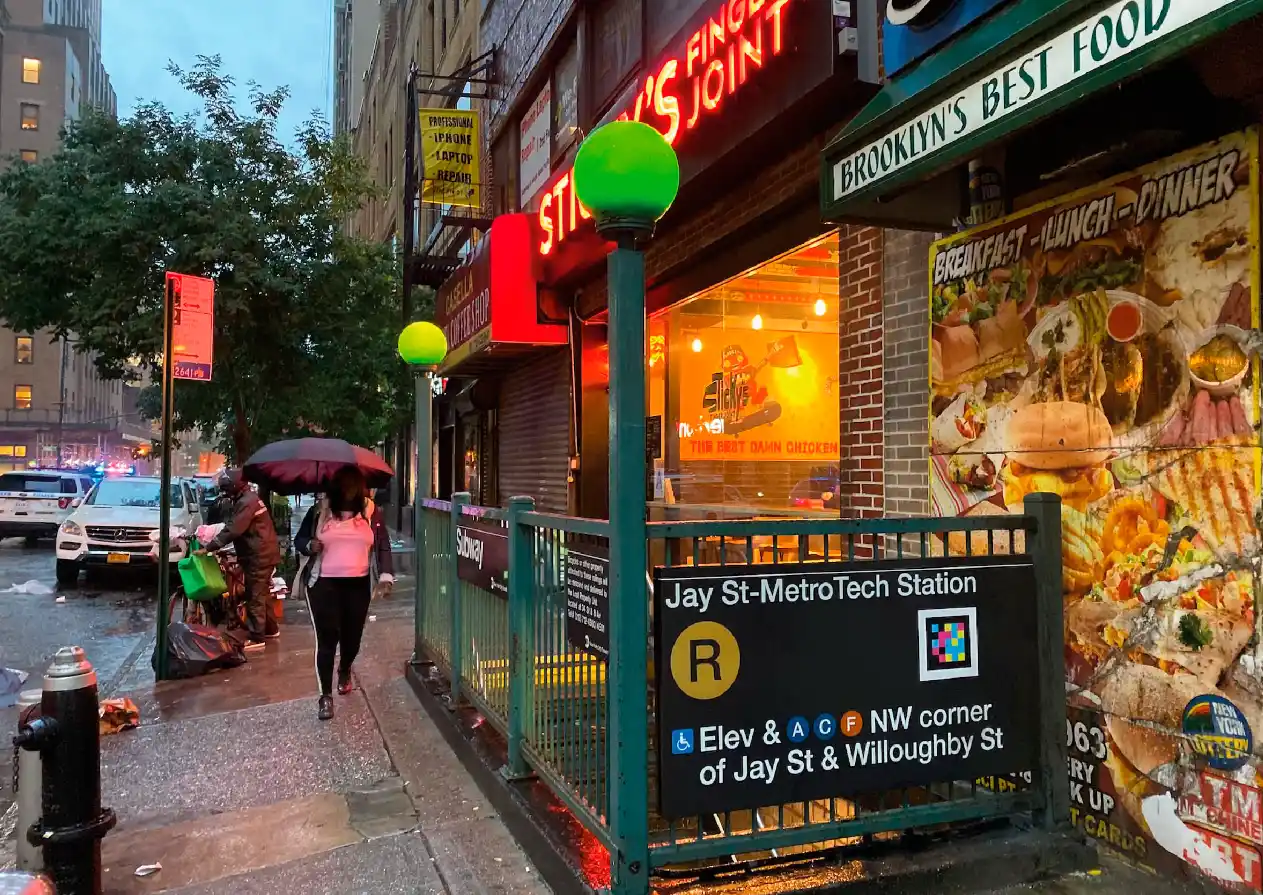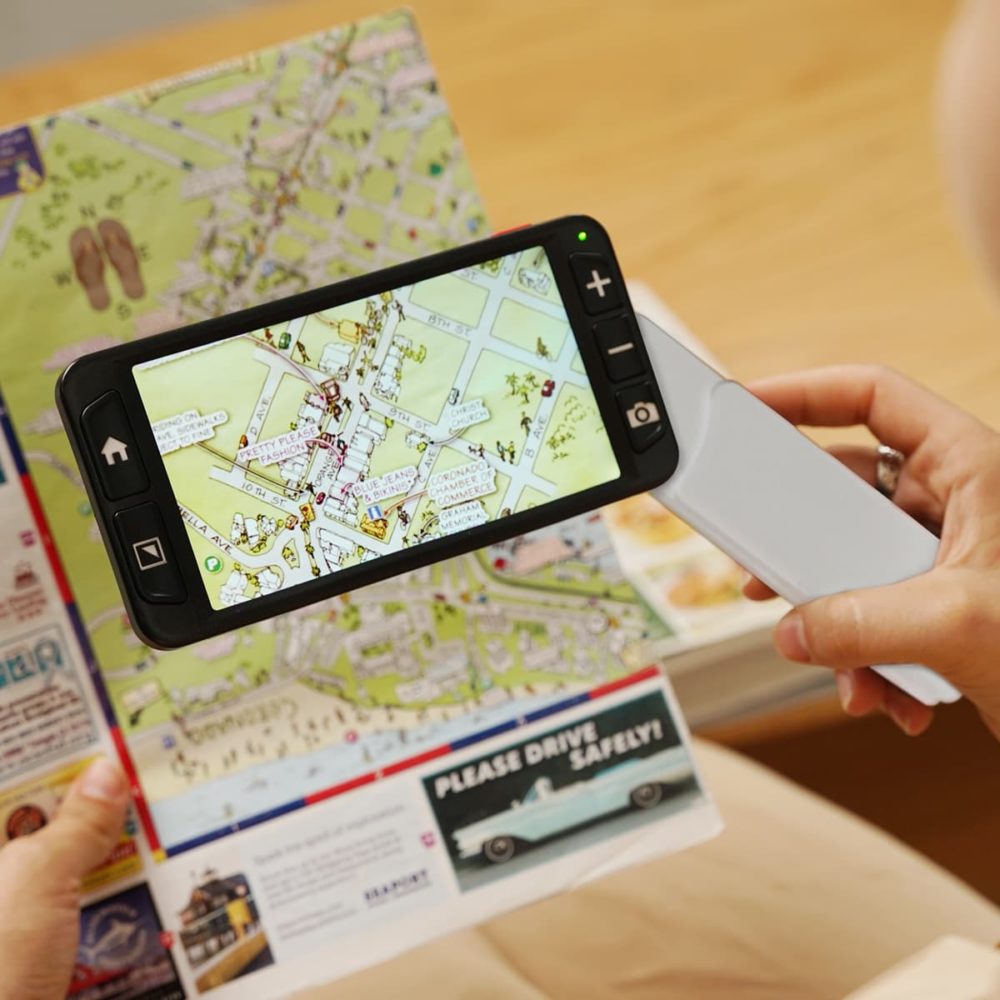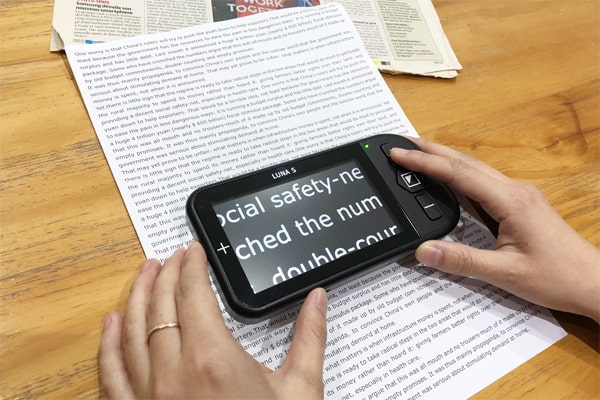People with low vision face unique challenges when using subways in the United States, such as recognizing station signs, locating train doors, and navigating complex station environments. However, with technological advancements and enhanced accessibility features, these challenges are becoming easier to overcome. This article provides a detailed guide on using existing tools and services to ensure safe travel, along with recommendations for portable electronic video magnifiers that can help in day-to-day situations.
1. Accessibility Features and Navigation Tools in Subway Systems
NaviLens and Other Navigation Tools
The Metropolitan Transportation Authority (MTA) in New York has introduced NaviLens, a smartphone application that helps low vision users navigate subway stations. By scanning QR codes placed throughout the station, users can access real-time information about train schedules, station services, and directional guidance. NaviLens also supports multiple languages, making it easier for users to navigate unfamiliar environments (MTA, 2024; APH ConnectCenter, 2023; Salus University, 2022).

NaviLens codes can be found various locations (NaviLens, n.d.)
Tactile Braille Maps and Floor Signage
Many subway stations provide tactile maps and Braille signs to help low vision passengers understand station layouts and identify exits (MTA, 2024). Additionally, New York subway stations have introduced blue-and-white floor decals that clearly mark accessible boarding areas. These decals guide low vision passengers to appropriate cars, especially when they need to use wheelchairs or walkers (Salus University, 2022; World Services for the Blind, 2020).

(Touch Graphics, n.d.)
2. Fare Discounts for People with Disabilities
Many subway systems in the United States offer fare discounts to individuals with disabilities, including those with low vision. For example, the MTA’s “Reduced-Fare MetroCard” allows qualified individuals to travel at half the regular fare. To apply, passengers need to fill out an application form and provide documentation from a healthcare provider confirming their disability (APH ConnectCenter, 2023; MTA, 2024). Other cities such as Boston and Los Angeles have similar programs. It’s advisable for passengers to check with local transit authorities for specific eligibility requirements.

(AiPassportPhotos, 2023)
3. Safety Tips and Mobility Skills for Low Vision Passengers
Orientation and Mobility (O&M) Skills
Orientation and Mobility (O&M) skills are crucial for building confidence and independence for low vision users. These skills include using a white cane to detect surroundings, identifying tactile warning strips at the platform edge, and safely boarding and exiting trains. Training can help users navigate stairs, avoid obstacles, and locate station facilities (Salus University, 2022; World Services for the Blind, 2020).
Seeking Assistance
Despite advancements in automation, human assistance remains a vital resource. Low vision passengers can request help from station staff, especially when navigating unfamiliar stations or transferring between lines. Many stations have service desks or helplines that passengers can use to ask for guidance, buy tickets, or get directions (APH ConnectCenter, 2023; World Services for the Blind, 2020).
4. Portable Electronic Video Magnifiers Recommendation
To help people with low vision read small print or signage in everyday situations, handheld electronic video magnifiers can be a valuable tool. Here are two recommended products:
Luna 6 Handheld Electronic Video Magnifier



The Luna 6 is a compact, easy-to-carry electronic video magnifier that offers multiple magnification levels and high-contrast options. It provides not only close-up magnification but also distance-viewing capabilities, allowing users to read signs, maps, and ticket information from a distance. Luna 6 is pocket-sized, making it convenient to carry and use in various settings. Additionally, it features a wireless charger, adding to its portability and ease of use.
Luna S Handheld Electronic Video Magnifier

The Luna S Handheld Electronic Video Magnifier is a compact, lightweight device that stands out for its portability. Weighing just 7 oz, it easily fits in your pocket, making it convenient to carry and use on the go. Its voice control feature allows for effortless hands-free operation, while the built-in radio function adds extra functionality, enhancing the overall user experience.
Here is a video about the difference between Luna 6 and Luna S:
5. Using Modern Technology to Enhance Travel Experience
Official Transit Apps and Real-Time Information
Many cities offer official transit apps that provide real-time updates on train schedules, delays, and station maps. Passengers can download these apps to plan their journey more effectively. For example, the Los Angeles Metro app offers live updates on buses and trains, along with route planning tools (Salus University, 2022).
Voice-Guided Navigation
Low vision users can utilize navigation apps like Google Maps, which feature voice-guided directions for walking routes. These apps can guide users through subway stations, helping them identify entrances, platforms, and exits (World Services for the Blind, 2020).
6. Accessible Transportation Services
For passengers who are unable to use regular subway services, many cities offer specialized transportation options. For example, New York’s Access-A-Ride service allows passengers to book door-to-door rides, eliminating the need for complex navigation through subway stations. This service is especially beneficial for passengers with additional mobility issues (MTA, 2024; Salus University, 2022).
Understanding Paratransit Services
Paratransit services in many cities can pick up passengers from their homes and take them directly to their destinations. To use these services, passengers must apply in advance and provide proof of disability. It is important to schedule these rides in advance, as they may require planning around fixed schedules.
Conclusion
With the improvement of accessibility features and advancements in technology, navigating subway systems has become easier and safer for individuals with low vision. By utilizing smart navigation tools like NaviLens, tactile maps, and voice-guided navigation apps, as well as learning essential mobility skills, low vision passengers can achieve greater independence. Moreover, the use of handheld electronic video magnifiers such as Luna 6 and Luna S enhances everyday visual experiences, allowing users to read small text and view signs from a distance more easily. Combining these tools with the fare discounts and specialized transportation services available in many cities, low vision individuals can confidently and conveniently travel using subway systems across the USA.
FAQ: Navigating Subway Systems for People with Low Vision
Q1: How can I find accessible subway stations and their features?
Most major cities provide detailed information about accessible stations on their transit websites. For example, the New York MTA offers a list of stations with accessibility features such as tactile Braille signs, audio announcements, and elevators. It’s advisable to visit the official site of your local transit authority or use navigation apps like NaviLens, which provide real-time accessibility information for specific stations (MTA, 2024; Salus University, 2022).
Q2: Which apps are most helpful for low vision travelers on the subway?
NaviLens and Google Maps are great tools. NaviLens uses QR codes to provide real-time station information, while Google Maps offers voice-guided navigation for walking routes, helping users identify entrances and platforms. Additionally, many transit systems have their own apps, like the Los Angeles Metro App, which provides live updates and route planning (World Services for the Blind, 2020; APH ConnectCenter, 2023).
Q3: Are there fare discounts available for individuals with low vision?
Yes, many U.S. cities, including New York, Boston, and Los Angeles, offer fare discounts to people with disabilities. To apply, you’ll typically need to provide medical documentation and complete an application for a reduced-fare card. It’s best to check the transit authority’s official website for specific eligibility and application procedures (MTA, 2024; APH ConnectCenter, 2023).
Q4: How can I get assistance at subway stations if I need help?
Subway systems usually have staff available to help passengers with purchasing tickets, navigating platforms, and finding the right train. For example, New York’s MTA staff are trained to assist passengers with disabilities. You can seek out service desks or approach security personnel for guidance. In some cities, help points with direct communication lines to staff are also available (World Services for the Blind, 2020; Salus University, 2022).
Q5: Can portable electronic video magnifiers like Luna 6 and Luna S assist me on the subway?
Yes, devices like Luna 6 and Luna S can greatly assist low vision travelers. Both are handheld electronic video magnifiers that offer distance-viewing capabilities, making it easier to read signs, maps, and other important information on the go. Luna 6 has a slightly larger screen and superior distance-viewing functionality, which makes it ideal for reading signs from farther away. It is also pocket-sized, easy to operate, and comes with a wireless charger for added convenience. Meanwhile, Luna S is more compact, weighing just 7 oz, and features voice control and a radio function.
Q6: What are paratransit services, and how do they benefit low vision travelers?
Paratransit services provide door-to-door transportation for individuals who may find it challenging to use standard subway services. For example, Access-A-Ride in New York allows passengers to book rides that pick them up from their homes and take them directly to their destination. These services usually require an application process, and rides should be scheduled in advance. This option can be an excellent alternative for those needing extra assistance or comfort during travel (MTA, 2024; Salus University, 2022).
References
APH ConnectCenter. (2023). Traveling on trains and buses. Retrieved from https://aphconnectcenter.org
AiPassportPhotos. (2023, August 7). The complete guide of New York MetroCard for seniors. Retrieved October 25, 2024, from https://www.aipassportphotos.com/blog/new-york-metrocard-for-seniors/
MTA. (2024). MTA accessibility and new technology solutions. Retrieved from https://new.mta.info/accessibility
NaviLens. (n.d.). NaviLens: Smart signage for a more inclusive world. Retrieved October 25, 2024, from https://www.navilens.com/en/
Touch Graphics. (n.d.). NYC subway tactile signage. Retrieved October 25, 2024, from https://www.touchgraphics.com/signs/nyc-subway
Salus University. (2022). Q&A: Navigating subway travel with visual impairments. Retrieved from https://www.salus.edu
World Services for the Blind. (2020). Public transportation tips for the blind and visually impaired. Retrieved from https://www.wsblind.org

